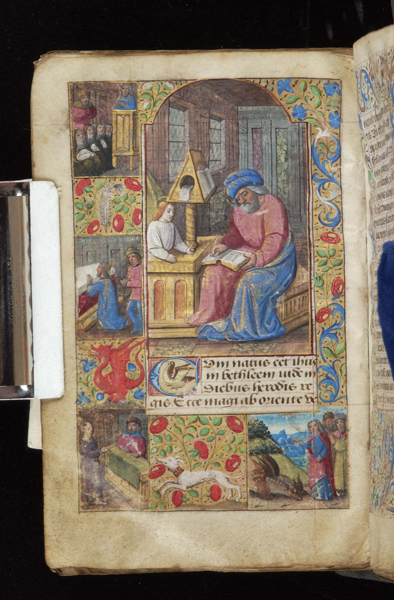
Accession number
MS M.815
Object title
Book of hours (MS M.815).
Created
Paris, France, between 1471 and 1485
Binding
English 16th-century painted vellum; in center of both covers a hind passant, surrounded by oak foliage and acorns; the letters +A+G+L+A+ (Altha Gebir Leilam Adonai - Thou, o Lord, art mighty for ever) are painted on the back cover.
Description
168 leaves (1 column, 23 lines), bound : vellum, ill. ; 170 x 120 mm
Provenance
Possibly owned by Henry VII of England (arms of England and some devices painted in the margins are associated with him: ostrich feathers, a porticullis, a white boar, red dragon, silver greyhound); Sir Robert Wingfield (1464-1539, his motto: Posse et nulle nobile on end flyleaf); on fol. 165v in a 16th-century hand are written he letters +A+G+L+A+ (Atha Gebir Leilam Adonai - Thou, o Lord, art mighty for ever; below in the same handwriting is a note: 183 leaves: leaues paynted: Nine score & three"); Mathias Lambrecht, bishop of Bruges (1594-1602, his motto Da Domine quod iubes et iube quid vis inscribed on fol. 165v and upper cover); purchased from Lathrop C. Harper, New York, in 1941.
Notes
Ms. book of hours for the use of Sarum; written and illuminated in Paris, France, ca. 1471-1485.
Decoration: 29 large miniatures, 11 with historiated borders; 10 small miniatures; 24 calendar borders with historiated vignettes; a 15th century miniature of the Crucifixion by a master of the Gold Scrolls Group has been cut from another manuscript and pasted to the inside of the front cover.
Artist: Chief Associate of Maître François (tentatively identified with François le Barbier [or François Le Barbier] fils [son], active ca. 1480-1501; see Mathieu Deldicque, Revue d'art, no. 183/2014-1, p. 9-18).
The artist Franç̧ois le Barbier [père] had a son François le Barbier [fils] who took over his father's atelier until his own death in 1501. Maître François and his chief associate have been proposed as this father-son team, the son finishing manuscripts begun by his father and following the same compositional schemes. The Master of Jacques de Besançon has also been suggested as the head of this atelier (see François Avril and Nicole Reynaud, Les enluminures du Louvre: Moyen Âge et Renaissance, Paris, 2011, p. 206).
Decoration: 29 large miniatures, 11 with historiated borders; 10 small miniatures; 24 calendar borders with historiated vignettes; a 15th century miniature of the Crucifixion by a master of the Gold Scrolls Group has been cut from another manuscript and pasted to the inside of the front cover.
Artist: Chief Associate of Maître François (tentatively identified with François le Barbier [or François Le Barbier] fils [son], active ca. 1480-1501; see Mathieu Deldicque, Revue d'art, no. 183/2014-1, p. 9-18).
The artist Franç̧ois le Barbier [père] had a son François le Barbier [fils] who took over his father's atelier until his own death in 1501. Maître François and his chief associate have been proposed as this father-son team, the son finishing manuscripts begun by his father and following the same compositional schemes. The Master of Jacques de Besançon has also been suggested as the head of this atelier (see François Avril and Nicole Reynaud, Les enluminures du Louvre: Moyen Âge et Renaissance, Paris, 2011, p. 206).
Script
bastarda
Language
Latin
Resources
Century
Catalog link
Classification
Department
